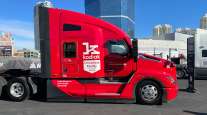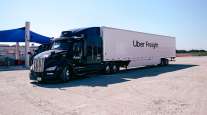Managing Editor, Features and Multimedia
CES Showcases Advances in AI, Truck Safety
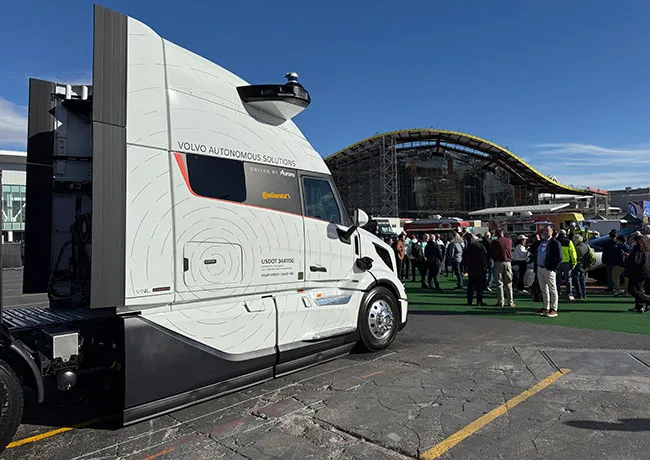
Self-driving truck developer Aurora and its supplier partner Continental showcase a Volvo VNL model outfitted with the Aurora Driver system at CES 2025 in Las Vegas. (Seth Clevenger/Transport Topics)
[Stay on top of transportation news: Get TTNews in your inbox.]
LAS VEGAS — From autonomous trucks to enhanced driver visibility in the cab, the commercial vehicle technologies on display at CES 2025 provided a potential glimpse at trucking’s near-term future.
The world’s largest showcase of emerging technologies, which runs Jan. 7-10, highlighted myriad use cases for artificial intelligence and emphasized the shift toward software-defined vehicles that can be continuously upgraded over time via over-the-air updates rather than hardware changes.
In the freight transportation sector, those two trends are coming together to support the ongoing development of autonomous trucks, which remained a focal point at CES.
Although the show floor at the West Hall of the Las Vegas Convention Center featured noticeably fewer heavy- and medium-duty trucks than in the past few editions of the event, trucking industry suppliers and tech companies continued to exhibit technologies aimed at boosting road safety and improving freight efficiency.
PHOTO GALLERY: Scenes from CES 2025
Aurora Innovation and Torc Robotics showed their latest autonomous truck designs alongside their supplier partners, while several providers of safety technology and connected vehicle systems demonstrated their products and shared their visions with attendees.
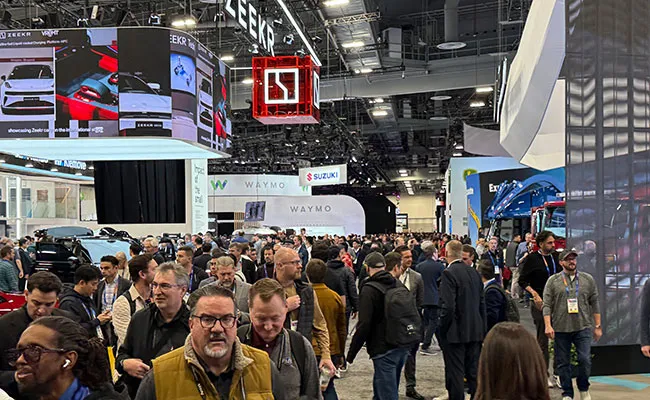
CES attendees explore emerging vehicle technologies and innovations on display in the West Hall of the Las Vegas Convention Center. (Seth Clevenger/Transport Topics)
The field of competitors in the autonomous vehicle sector shrank in December when General Motors announced it would wind down its Cruise robotaxi business. Several self-driving truck developers also have exited the space in recent years.
Despite those departures, Torc CEO Peter Vaughan Schmidt said the business opportunity for autonomous trucks remains clear in an industry in which fleets operate on thin margins and have long struggled to attract and retain drivers.
“We are solving a true business problem,” he said.
Torc aims to commercialize fully autonomous trucks in hub-to-hub operations by 2027, beginning in Texas.
Vaughan Schmidt predicted that the developers that reach the commercialization phase will be few in number but well equipped in terms of talent and funding.

Vaughan Schmidt
“We are still here, and we will be here in 2027,” he said. “We will have a few strong competitors, but not many. It will be fierce competition with really strong players.”
Autonomous truck developers continue to lay the foundation for large-scale commercialization through partnerships with established industry suppliers.
Aurora and its manufacturing partner, Continental, have joined forces with chipmaking giant Nvidia, the companies announced at CES.
Nvidia will supply its next-generation Drive Thor in-vehicle computing platform for integration into the Aurora Driver autonomous driving system, which Continental plans to mass produce in 2027.

Aruna Anand, president of Continental Automotive North America, outlines the company’s collaboration with Aurora and Nvidia. (Seth Clevenger/Transport Topics)
“We are working now together to power autonomous trucking to scale,” said Aruna Anand, president of Continental Automotive North America.
Continental’s CES exhibit featured the Aurora Driver installed on a Volvo VNL tractor.
In the near term, Aurora now plans to begin operating fully driverless trucks with no safety driver behind the wheel in April after pushing back its previously stated target of doing so by the end of 2024. That launch will begin with one unmanned truck operating between Dallas and Houston and then expand to additional vehicles on that lane.
This milestone will mark the beginning of Aurora’s goal to commercialize tens of thousands of autonomous trucks, said Bart Nabbe, Aurora’s vice president of corporate development and strategic partnerships.
“It will start with that first vehicle,” he said. “It will start with that very first commercial operation of a driverless vehicle on the road without a driver.”
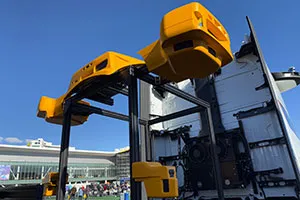
A display at Continental’s booth shows hardware components of the Aurora Driver that it will supply for autonomous Class 8 trucks. (Seth Clevenger/Transport Topics)
Torc, meanwhile, showcased a Freightliner Cascadia model equipped with its autonomous driving system as part of an exhibit hosted by sensor technology supplier Aeva.
RELATED: States Prepare Rules for Autonomous Vehicles
Torc, an independent subsidiary of Daimler Truck, last year selected Aeva to supply long-range lidar for its series production autonomous trucks. Aeva’s 4D lidar sensors are designed to detect both the position and velocity of other vehicles and objects, enabling autonomous vehicles to respond more safely.
Several days before CES, Torc and Aeva announced they were expanding their existing partnership through increased data-sharing and deeper collaboration between their engineering teams.
During the show, Torc also announced it signed a lease for a new autonomous truck hub in the Dallas-Fort Worth area for testing and commercial operations.
This new hub will support Torc’s plans to deploy and commercialize autonomous trucks in Texas between Dallas and Laredo, an important freight lane that is expected to see growing volumes as businesses shift overseas manufacturing to Mexico.
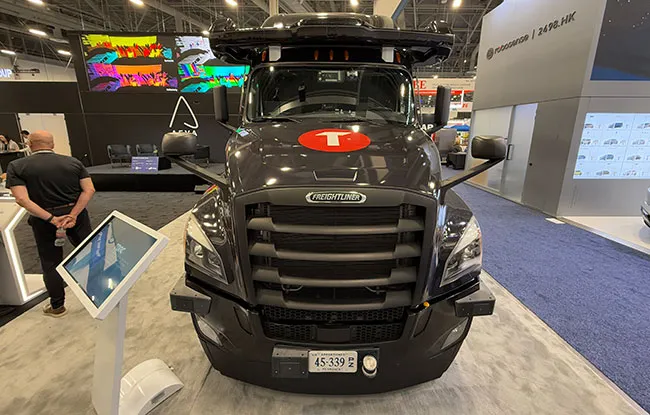
Torc Robotics and its long-range lidar supplier, Aeva, showcase a self-driving Freightliner Cascadia. (Seth Clevenger/Transport Topics)
Apart from autonomous trucks, exhibitors also showcased various technologies designed to assist professional drivers.
Stoneridge, for one, presented its vision for the truck cab of the future, with digital displays providing the driver with 360-degree views around the vehicle.
The company exhibited a Class 8 tractor outfitted with its MirrorEye system, which uses onboard cameras and digital displays in the cab to replace traditional side mirrors and improve visibility.
RELATED: AI, Holograms, EVs Shaping Future In-Cabin Experiences
The MirrorEye system was paired with in-cab display hardware provided by BOE Varitronix, including a prototype center high-mount display showing views of the sides of the truck captured by two downward facing side cameras, along with a view of the space directly in front of the vehicle from a camera mounted above the grille. The display also included pedestrian detection warnings.
Yet another digital display provided the driver with a range of vehicle data and video from a trailer visibility system that uses trailer-mounted cameras to capture views around, behind and inside the trailer.
The system is designed to alleviate a common source of anxiety for truck drivers — limited visibility from the driver’s seat, said Troy Cooprider, Stoneridge’s chief technology officer.
“The mission we set for ourselves is to remove all blind spots around the truck and trailer,” Cooprider said.
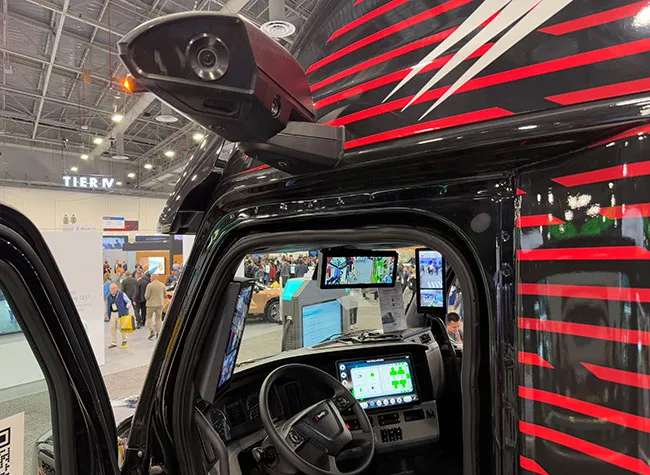
Stoneridge shows off an enhanced version of its MirrorEye camera monitoring system that provides 360-degree views around the vehicle via multiple digital displays in the cab. (Seth Clevenger/Transport Topics)
The MirrorEye system, available as a factory or aftermarket installation, has been deployed by more than 40 fleets in North America.
Amid the many use cases for AI highlighted at CES, fleet safety represents a clear opportunity for the transportation industry.
Steven Ursaki, director of business development at Nauto, said AI can help fleets and drivers better navigate the many risk factors that can contribute to crashes or near misses.
Nauto’s camera-based safety system utilizes AI to provide in-cab collision warnings, detect pedestrians and cyclists, and prevent distracted driving while accounting for complex driving conditions.
“The secret sauce is data,” Ursaki said.
CES exhibitors also showed how they are enabling the movement toward software-defined vehicles.
Truck Parking Club's Evan Shelley discusses how innovative platforms are turning available space into opportunities for reserved parking. Tune in above or by going to RoadSigns.ttnews.com.
QNX, the automotive division of BlackBerry, launched QNX Cabin, a cloud-based development platform for vehicle manufacturers to design digital vehicle cockpits, including functions like infotainment, advanced driver-assistance systems and the digital instrument cluster.
“When vehicle makers are looking to deploy services, it can be done more rapidly,” said Niko Hammond, vice president of business development at QNX.
At a CES news conference, global automotive supplier Bosch emphasized the expanding role of software and AI in vehicle development, both today and in the future.
“Intelligent software and digital services have become cornerstones of our core business,” said Tanja Rueckert, a member of Bosch’s board of management.
The Germany-based company said it expects to generate sales of more than 6 billion euros from software and services by the beginning of the next decade, with about two-thirds of that total coming from its mobility business.
In another example of connected vehicle technology at CES, South Korea-based BANF demonstrated its intelligent tire system, which uses tire-mounted sensors and wireless charging to capture data, such as tire pressure, wheel alignment, tread wear, heat levels and roadway conditions.
Want more news? Listen to today's daily briefing below or go here for more info:



